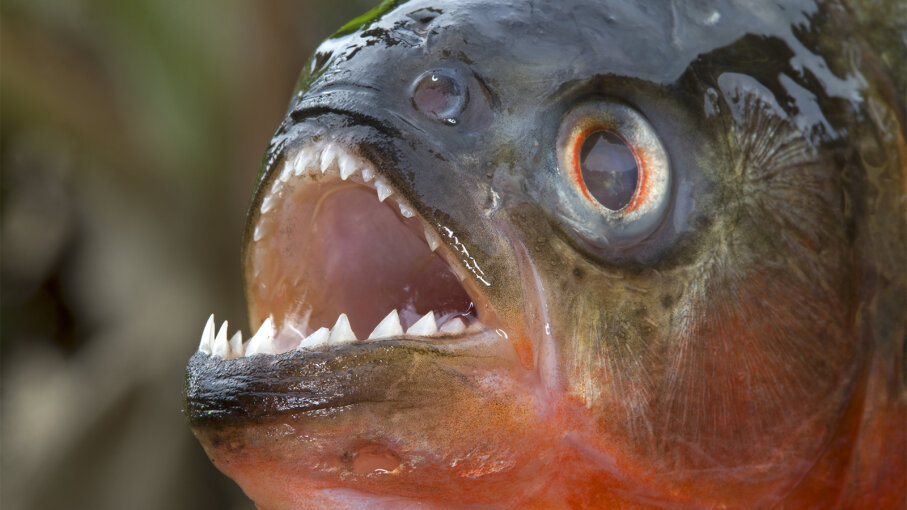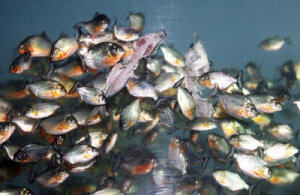
..................................................................................................................................................
Piranhas
 |
| The red-bellied piranha (Pygocentrus nattereri) feeds on bits of flesh and fins nipped from the tails of other fish, insects, smaller fish and some plant material, such as figs or other fruits. |
Toothy Nippers With a Bad Reputation
BY JESSLYN SHIELDS
Sometimes an
animal just captures the collective imagination in a way that, while
sensational, might not be entirely justified.
Take the
piranha, a toothy South American freshwater fish that has been the subject of
not one, not two, but five Hollywood horror movies.
Sure, they've
got big teeth, but are they really as ferocious as their reputation?
Piranhas occur
naturally only in the Amazon,
but have been introduced into freshwater systems in other parts of the world,
mostly through the tropical fish trade.
They are
illegal to keep as pets in most U.S. states, although
most piranha species wouldn't be able to survive in a place much colder than
Florida anyway.
Not All Piranhas Are Carnivores
It's very
difficult to say how many piranha species there are in the Amazon basin, though
around 40 are recognized by the scientific community.
We don't know
a lot about the habits of piranhas in the wild — much of what we know, we
learned from keeping them in aquaria, and most animals tend to act differently
in captivity.
The largest
piranhas grow to be about 2 feet (0.6 meters) in length, but many species max
out at about half that length.
Their jaws are
lined with a single row of saw-like interlocking teeth that resemble shark
teeth — razor sharp and always exposed due to a pronounced underbite.
Most piranha
species eat meat, but just because you have a jaw three times more powerful than a
similarly-sized alligator and can bite through the plates of
the most heavily-armored fish of the Amazon doesn't mean you have to eat meat
all the time.
Piranhas, like
most wild animals, eat what they can get.
A typical
piranha diet includes a lot of worms and insects, other fish, some carrion they
find in the river, as well as seeds and vegetation.
Depending on
the species, the ratio of these elements vary — some piranha species are entirely
vegetarian, while others, like the infamous red-bellied
piranha, reportedly wait
in the weeds every evening in groups of 20-30 to ambush prey.
Piranhas "Bark"
An underwater
environment is full of sounds just like the ones in your neighborhood, and in
the Amazon, piranhas are pretty noisy neighbors.
They make
distinctive "barking" noises by squeezing their swim bladders into
different shapes.
According to
Rodney Rountree, a marine biologist and an expert in fish sound production, who
has studied piranha
vocalizations in the Amazon basin in Peru, the patterns of each
species' underwater barks are very distinctive, which can help scientist
looking for piranha in murky waters figure out which species are in an area
without even catching them — all that's needed is a mic in the water.
Not only do
different piranha species vocalize differently, piranhas make different types
of noises to communicate different messages.
For instance,
a "bark" might be a warning for another fish to back off, while a
group of piranhas may emit an intimidating chorus of grunts as they gather
around a prey item.
"You hear all sorts of fish in the soundscape," says
Rountree.
"There are many different species of catfish, for instance.
In the areas where I was catching piranhas for my research, I was hearing other
fish sounds, and it became obvious that it was the sound of other fish
screaming because they were being bitten by piranhas."
Piranhas Are "Nippers"
 |
| A school of red-bellied piranha (Pygocentrus nattereri), which can have a lifespan of 10 years or more. |
For instance,
that classic situation in movies wherein a cow steps into a river and is
immediately pulled under and stripped to the
bone by a pack of hungry piranhas isn't really something that
happens in real life.
The waters of
the Amazon are often very opaque — full of silt and tannins — and fish can't
see very well, so they find their prey by smell or proximity.
Most piranhas
are "nippers," meaning they feed by sneaking up on their prey and
shearing off a single chunk of flesh. It doesn't much matter to the piranha who
it is — they'll even take bites out of each other.
According to
Rountree, this "nipping behavior" isn't unique to piranhas — in fact,
it's fairly common among fish in the Amazon.
"There are all kinds of fish that just take a little chunk
out of other fish," he says.
"Many of the fish are armored — especially some of the
catfishes have heavy, boney scales — and part of this is for defense."
Teddy Roosevelt and the Piranha
 The Amazon is
full of fearsome underwater killers — electric eels,
for one, are arguably a good deal more deadly than piranhas.
The Amazon is
full of fearsome underwater killers — electric eels,
for one, are arguably a good deal more deadly than piranhas.
However, in
1913, former U.S. president Teddy Roosevelt took a pleasure cruise
in the Brazilian Amazon ( and it very nearly killed him).
At one
settlement, locals showed Roosevelt a pool full of starving piranhas, and
reportedly fed a live cow to
the fish to show off their ferocity.
Roosevelt was really struck by their killing prowess and wrote
about the piranhas in his journal,
describing the experience and calling them, "the most ferocious fish in
the world."
According to
Rountree, while a piranha might take a single chunk out of you, the devouring
of a cow is virtually unheard of:
"In some areas during the dry season, when water levels
draw down to pools and shallow areas where the piranhas get concentrated —
those situations could probably be quite dangerous. This is when feeding
frenzies happen — not like stripping animals to the bone or anything, but you
wouldn't want to go swimming in them."
NOW THAT'S INTERESTING
The
Megapiranha, a piranha species that lived around 10 million years ago in the
Late Miocene, probably had the most powerful bite of
any animal, ever.
Jesslyn
Shields
is a freelance science writer working out of Athens, Georgia. She writes about
brand new research for HowStuffWorks. Since 2010, Jesslyn's written science
news and content for educational videos, because she loves to always have
something new to yammer on about at parties. You can find her online at www.jesslynshields.com


No comments:
Post a Comment